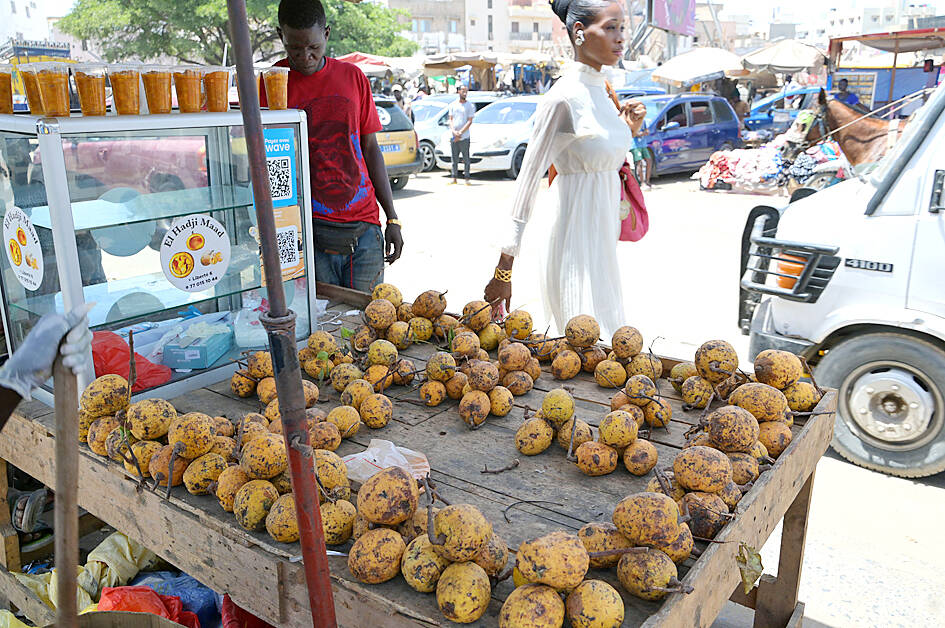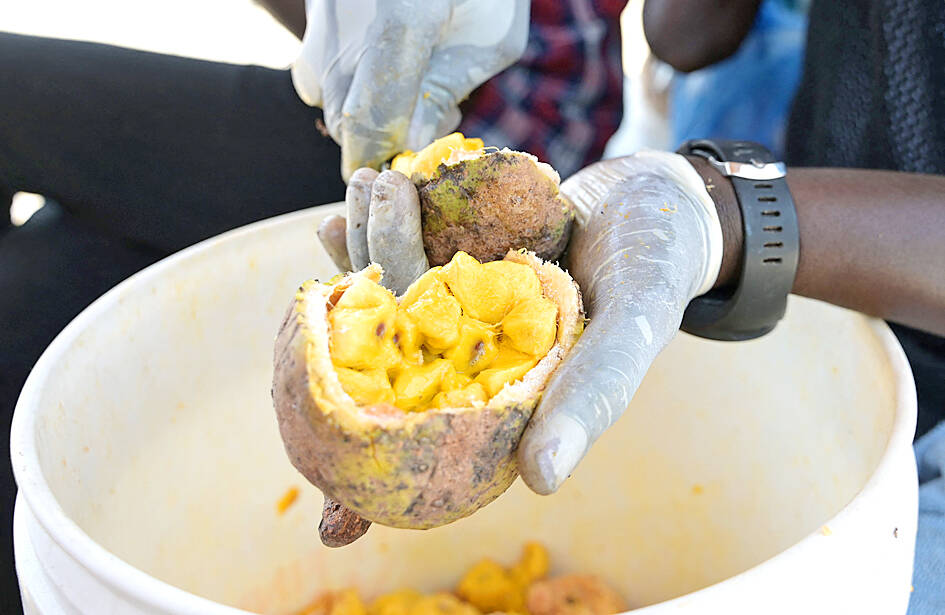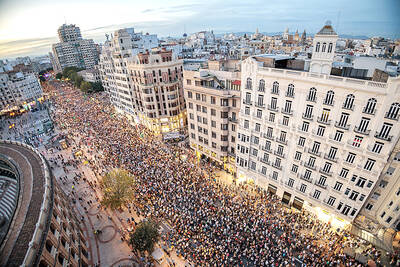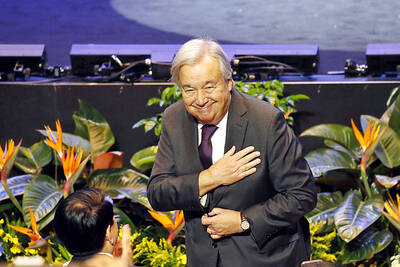Outside a bustling fruit market in Senegal’s Dakar region, three trucks blocked the road while a dozen men sweated to unload a precious cargo.
Working in intense heat and racing against the clock, they were shifting 60 tonnes of maad — a delicate tropical fruit that is massively popular in the West African state.
A yellow fruit with a pulp that has a distinctive sweet and sour flavor and is rich in vitamins and fiber, maad comes from a vine called Saba senegalensis, which grows wild and is common across the region.

Photo: AFP
The fruit’s season is relatively short, running from May to August, which prompts a rush of sellers at street corners, hawking the delicacy with salt, sugar or chilli, blended into juice or turned into jam.
Maad has different names across West Africa, where it is eaten from the Ivory Coast to Mali and Guinea — but it is most popular in Senegal.
Countless jobs depend on the fruit, from harvesting and distribution to selling and processing.

Photo: AFP
At the Sandika market in Pikine, workers labored to empty the trucks that had just arrived, sorting the maad according to ripeness.
“The unloading will be finished by the end of the day,” said Dame Sarr, a 28-year-old wholesaler, who with his uncle had invested 6 million CFA francs (US$10.020) in the consignment.
They expected to clear the equivalent of at least US$1,000 in profit — if the fruit was sold fast.
“If I don’t shift the goods, I will have to cut the price tomorrow, because with every passing day maad loses its quality,” he said, sitting under a parasol.
The good news was that several customers were already hovering around.
Sarr had separated out the finest fruit to sell for 4,200 CFA francs for a bucket of 40 pieces. The others were on sale for half that price. A 20kg box of maad cost between 20,000 CFA francs and 25,000 CFA francs.
“Maad is a very risky investment. It can’t stand sunlight or rain, and transporting it is difficult,” market representative and salesman Djiby Sandika said.
The fruit “best suits small-scale retailers, who make large profits,” Sarr said.
In Senegal most maad grows in the southern Casamance region on vines that wrap themselves around trees in thickly forested areas.
Picking the fruit is done by hand and involves using long sticks — a task that involves the added risk of snakes.
The Economy, Territory, Development and Service (ETDS) non-governmental organization said that nearly 1,500 tonnes of maad are harvested annually in the Ziguinchor, Kedougou and Kolda areas.
Mariama Dieme, who heads a project to market maad production in Casamance, said that with better access, output could be trebled.
The fruit is already under threat from “over-exploitation,” from fires used to burn stubble from fields and from damage caused by forest hunters, Dieme said.
The ETDS is fostering a program for small-scale woman-led producers to make maad jam, juice or syrup, and even export some of their production.
Maad jam sold in France via sellers on Instagram costs 25 euros (US$27.38) for a 300g jar, said Fatou Binetou Adour, a Senegalese who lives in Paris.

DOUBLE-MURDER CASE: The officer told the dispatcher he would check the locations of the callers, but instead headed to a pizzeria, remaining there for about an hour A New Jersey officer has been charged with misconduct after prosecutors said he did not quickly respond to and properly investigate reports of a shooting that turned out to be a double murder, instead allegedly stopping at an ATM and pizzeria. Franklin Township Police Sergeant Kevin Bollaro was the on-duty officer on the evening of Aug. 1, when police received 911 calls reporting gunshots and screaming in Pittstown, about 96km from Manhattan in central New Jersey, Hunterdon County Prosecutor Renee Robeson’s office said. However, rather than responding immediately, prosecutors said GPS data and surveillance video showed Bollaro drove about 3km

Tens of thousands of people on Saturday took to the streets of Spain’s eastern city of Valencia to mark the first anniversary of floods that killed 229 people and to denounce the handling of the disaster. Demonstrators, many carrying photos of the victims, called on regional government head Carlos Mazon to resign over what they said was the slow response to one of Europe’s deadliest natural disasters in decades. “People are still really angry,” said Rosa Cerros, a 42-year-old government worker who took part with her husband and two young daughters. “Why weren’t people evacuated? Its incomprehensible,” she said. Mazon’s

‘MOTHER’ OF THAILAND: In her glamorous heyday in the 1960s, former Thai queen Sirikit mingled with US presidents and superstars such as Elvis Presley The year-long funeral ceremony of former Thai queen Sirikit started yesterday, with grieving royalists set to salute the procession bringing her body to lie in state at Bangkok’s Grand Palace. Members of the royal family are venerated in Thailand, treated by many as semi-divine figures, and lavished with glowing media coverage and gold-adorned portraits hanging in public spaces and private homes nationwide. Sirikit, the mother of Thai King Vajiralongkorn and widow of the nation’s longest-reigning monarch, died late on Friday at the age of 93. Black-and-white tributes to the royal matriarch are being beamed onto towering digital advertizing billboards, on

POWER ABUSE WORRY: Some people warned that the broad language of the treaty could lead to overreach by authorities and enable the repression of government critics Countries signed their first UN treaty targeting cybercrime in Hanoi yesterday, despite opposition from an unlikely band of tech companies and rights groups warning of expanded state surveillance. The new global legal framework aims to bolster international cooperation to fight digital crimes, from child pornography to transnational cyberscams and money laundering. More than 60 countries signed the declaration, which means it would go into force once ratified by those states. UN Secretary-General Antonio Guterres described the signing as an “important milestone,” and that it was “only the beginning.” “Every day, sophisticated scams destroy families, steal migrants and drain billions of dollars from our economy...